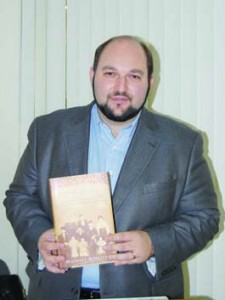Armen Melidonian
Staff Writer

The Fig Garden Branch of the Fresno Public Library hosted author Michael Bobelian at 7:00 pm on Thursday, October 1, for a book signing and to discuss his newly released Children of Armenia: A Forgotten Genocide and the Century-Long Struggle for Justice. This was Bobelian’s last stop in California for a series of public book readings before returning to New York. The novel delves into various efforts by Armenians to seek recognition and justice on the Armenian Genocide, decades after the event, and how the denial and silence that followed affected them.
Bobelian began by reading the prologue of the book, which introduces Gourgen Yanikian, a seventy-seven year old Armenian who decides to avenge the crimes of the Armenian Genocide by killing two Turkish consuls living in Southern California in the late 1970s. The narrative shifts to the late 1800s when Yanikian was born and discusses the 1895-1896 pogroms throughout the Ottoman Empire, then jumps to the year 1915 when Yanikian witnesses the aftermath of the massacres in his hometown. Bobelian presented news articles that covered the pogroms and the 1915 Armenian Genocide. News events were researched and brought up in the novel’s narrative, some of which he discussed in his presentation. Scans and excerpts from several New York Times articles were presented, and Bobelian demonstrated that “the event was widely known at the time,” but was forgotten and ignored decades later.
Bobelian also noted that the victims of the Genocide inspired the first international aid program and that the Armenians were the first recipients of such a campaign. America was at the forefront of the aid programs, with campaigns raising funds for relief efforts, American-style posters promoting the cause, and involvement of prominent American celebrities, businessmen, and philanthropists, including Chaplin, Rockefeller, and Fitzgerald.
Bobelian then contrasted a quote from Herbert Hoover, “probably Armenia was known to the school child in 1919 only a little less than England…”, with a quote from Hitler a week before the German invasion of Poland, “who, after all, speaks today of the annihilation of the Armenians?”
Although America had championed relief programs for Armenians during the Genocide, by the mid-1940s, America, which Turkey considers to be its strongest ally, sided with Turkey in its opposition to the Soviet Union. Bobelian summarizes the subsequent situation as an issue of recognition and remembrance of the event in the news and around the world. “The reason why the Armenian Genocide became the forgotten genocide was because the world moved on.” This was contrasted to remembrance of the Holocaust. Books, films, museums, and monuments would help serve as strong reminders of the event, but for the Armenian Genocide, serious, successful efforts were not realized until the mid-1960s. In 1965, the 50th anniversary of the Genocide, there was a “resurrection.” Armenians around the world held demonstrations, including in Soviet Armenia, where the largest gatherings occurred in Yerevan.
Two major hurdles to recognition of the Genocide by the United States were discussed. The first was that the world had moved on and wasn’t interested in covering events related to remembrance of the Genocide. The second issue, an important one covered in the novel, is that Turkish denial and pressure was being put on the media and on academics. The Armenian Diaspora called for legislation by various governments. Not until the 1980s did the Armenians in the United States have a leader in Washington pushing for a Genocide Resolution — Senator Bob Dole (R-Kansas). The Senator recognized the Genocide, and his Resolution in 1990 sparked months of debate in Congress. Supporters of the effort included Senators and Armenian advocates, who had a $1 million budget. Opponents to the Resolution included Turkey and eight lobbyist firms with a $3 million budget. Many in the government, such as the President and State Department, and Senate Appropriations Chairman Robert Byrd (D-West Virginia) opposed the resolution. Dole called the struggle a “David versus Goliath” situation.
The cover of the novel shows a family photo from 1908. The man with his leg crossed in the photo had purchased life insurance from New York Life and given it to his sister, Elizabeth, who stands behind him in the photo. The whole family died in the Genocide except for Elizabeth. She tried to collect on the insurance policy, but was refused by the insurance company. Her grandson inherited the policy and is continuing that effort today. Bobelian discussed how this is one prominent example of “ghosts of the past” calling for recognition.
The novel features three narratives about the people who are fighting for recognition of the Armenian Genocide: a man avenging the death of his family and people into his old age; a lawyer trying to get a class-action lawsuit against New York Life for life insurance policies that were denied to their recipients; and the efforts to get a Genocide resolution passed in the United States government supported by Senator Bob Dole.
Children of Armenia: A Forgotten Genocide and the Century-Long Struggle for Justice was published in September 2009 and is now available in local bookstores and from online vendors.
 Hye Sharzhoom Armenian Action
Hye Sharzhoom Armenian Action